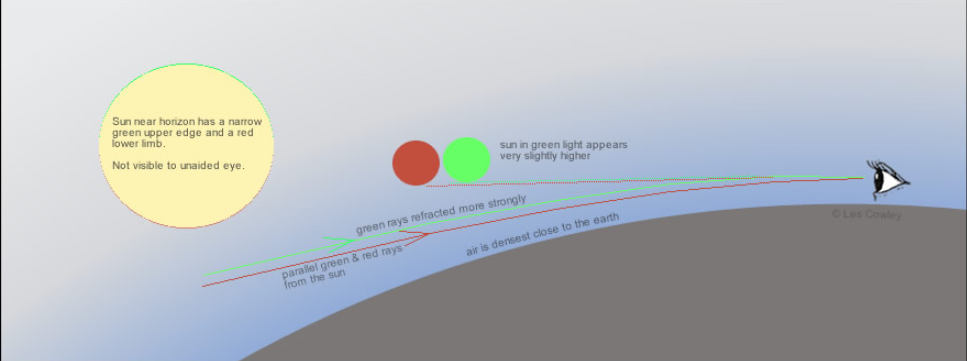Green Rim
Exploring the Phenomenon of the Green Rim
Have you ever noticed a slight green edge on the upper limb of the sun? Or perhaps a red hue on its lower limb? These intriguing optical phenomena are known as the "Green Rim" and the "Red Rim," respectively. In this article, we will delve deeper into the science behind the Green Rim, shedding light on its causes and how it manifests in our atmosphere.
The Green Rim occurs due to the gradual decrease in atmospheric density as we move away from the Earth's surface. As light rays from celestial bodies such as the sun, moon, or stars pass through the layers of increasing density and refractive index, they become refracted, curving towards the regions of greater density. This refraction causes objects in the sky to appear slightly higher than their actual position. The effect is most pronounced near the horizon, where it lifts the sun and moon by approximately 0.5° - roughly equivalent to their own diameter.
One might wonder why the Green Rim specifically appears on the upper limb of the sun and not elsewhere. The answer lies in the phenomenon of dispersion. Blue and green light are refracted more strongly than red light, resulting in the separation of colors. In other words, blue and green light deviate from their original path more significantly than red light as they pass through the atmosphere. Consequently, when we observe the sun, the blue and green components appear higher than the red component, creating a distinct green rim.
While a blue rim is also possible in theory, it is a rarity. This is because blue light is more readily scattered away by particles in the atmosphere. The scattering phenomenon causes blue light to disperse in various directions, making it less likely to contribute to the formation of a visible rim. As a result, the green rim remains the dominant feature in this optical phenomenon.
It is worth noting that the green rim is too narrow to be visible to the naked eye. Attempting to observe it using binoculars or a telescope is strongly discouraged, as it may cause severe eye damage. However, the green rim is just one piece of the puzzle when it comes to witnessing a green flash. To observe a green flash, one requires the ideal conditions provided by mirage effects, which offer significant vertical image magnification.
In conclusion, the Green Rim is a captivating atmospheric optical phenomenon that adds a touch of intrigue to our skies. Its appearance is a result of the dispersion of light and the gradual change in atmospheric density. While the green rim itself is too narrow to be seen without aid, it plays a crucial role in the occurrence of a green flash. So, keep your eyes peeled for these fascinating spectacles and marvel at the wonders of our atmosphere.


Green Rim - imaged by Tamás Ladányi (site, TWAN) in Hungary. ©Tamás Ladányi, shown with permission.
The sun has a slight green edge to its upper limb and a red one on the lower. The atmosphere decrases in density away from the surface. Light rays from the sun, moon or stars are refracted as they pass downwrards through the layers of increasing density and refractive index. The resulting ray curvature is towards the greater density and it makes objects in the sky appear slightly higher than they really are. The effect is strongest near the horizon and there it lifts the sun and moon by about 0.5� - their own diameter.
Blue and green light is refracted more strongly than red (dispersion) and the 'green sun' appears higher than the red thus creating a green rim. A blue rim is rare because blue light is more strongly scattered away by the atmosphere.
The green rim is too narrow to be visible to the unaided eye - never, ever, use binoculars or a telescope! - and is only part of the reason that we sometimes see a green flash. Green flashes need the considerable vertical image magnification provided by mirage conditions.

Note: this article has been automatically converted from the old site and may not appear as intended. You can find the original article here.
Reference Atmospheric Optics
If you use any of the definitions, information, or data presented on Atmospheric Optics, please copy the link or reference below to properly credit us as the reference source. Thank you!
-
<a href="https://atoptics.co.uk/blog/green-rim/">Green Rim</a>
-
"Green Rim". Atmospheric Optics. Accessed on November 23, 2024. https://atoptics.co.uk/blog/green-rim/.
-
"Green Rim". Atmospheric Optics, https://atoptics.co.uk/blog/green-rim/. Accessed 23 November, 2024
-
Green Rim. Atmospheric Optics. Retrieved from https://atoptics.co.uk/blog/green-rim/.